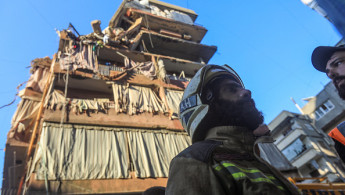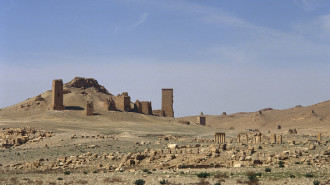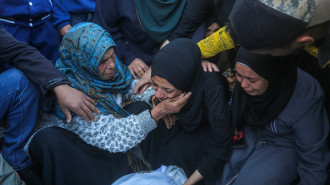Can Israel's claims about Hezbollah rockets stored in Lebanon homes be trusted?
After close to a year of its assault on Gaza and cross-border fire with Hezbollah, Israel has stepped up attacks on Lebanon, killing at least 558 people in strikes on Monday.
The indiscriminate nature of the attacks, which killed at least 50 children in one day, mark a continuation of Israel's policies employed in Gaza, where Israel has said civilians are being used as human shields.
Tel Aviv has now made similar claims about Lebanon, where it says Hezbollah is storing missiles and other arms in civilians' homes.
The New Arab takes a look at Israel's latest claims.
'Rockets in homes'
"For over 20 years, Hezbollah has deployed its arms inside homes and militarised civilian infrastructure. As a result, the Hezbollah terrorist organisation has turned southern Lebanon into a battlefield," Israeli army spokesman Rear Adm. Daniel Hagari alleged in a video posted by the military's X account on Monday.
"This is a village in southern Lebanon, Hezbollah stores cruise missiles, rockets, launchers and UAVs inside civilian homes, hidden behind the Lebanese population living in the village. We are monitoring these activities, locating the weapons and destroying them with precise intelligence-base strikes," he continued, as a computer-generated image of a cross-section of civilian buildings containing missiles and other military equipment.
Similar imagery was used by Israel in late October 2023, when it was claimed that a sophisticated Hamas "command and control centre" existed under Gaza's Al-Shifa Hospital.
The graphics created by Israel ahead of Al-Shifa's invasion showed a network of tunnels containing meeting rooms and weapons armouries being patrolled by armed militants.
An investigation carried out by Forensic Architecture in January which analysed Israel's claims exposed serious flaws in evidence presented by Tel Aviv to the ICJ, using 3D modelling, geolocation, OSINT, image complex, pattern analysis and shadow analysis.
WATCH: IDF Spox. RAdm. Daniel Hagari explains how Hezbollah exploits civilian infrastructure as weapons storage sites and uses the Lebanese people as human shields: pic.twitter.com/nuNG8OEo8G
— Israel Defense Forces (@IDF) September 23, 2024
"Our findings also indicate that the computer-generated graphics alleging an extensive tunnel network beneath Al-Shifa are nothing like the Israeli military’s own claims about the tunnel footprint on 22 November," the report reads.
"We also found that their 27 October claim (which accompanied the computer-generated graphics) that a ‘command and control centre’ existed beneath Al-Shifa contradicts the claims they subsequently made and evidence they presented on 20 November."
A Hamas "command and control" centre was never uncovered under the hospital.
Similar claims were made about other hospitals targeted in Gaza, including the Al-Rantisi Children's Hospital, which Hagari personally visited and claimed to have discovered an Arabic-language document listing the names of guards who were minding hostages. Arabic speakers later pointed out that the paper was a calendar listing the days of the week.
Early on Tuesday, the Israeli army also deleted a post from X which claimed that a "rocket weighing over 1 ton" was discovered in a warehouse in Lebanon. No explanation was given for the removal.
Hezbollah capabilities
Amid the months of cross-border exchanges between Hezbollah and Israel, the Lebanese group has released images purportedly showing a vast tunnel complex that appears more sophisticated than those used by Hamas.
In a video released in August titled "Our mountains are our stores", the group claimed to hold a vast array of precision and non-precision weapons, showing images of militants and goods trucks moving underground.
Observers have questioned why Hezbollah would store its arms in civilian homes when its tunnel network is reputedly older and larger than that of Hamas in Gaza.
"These are images of Hezbollah’s underground network shown in recent videos by the party. Israel wants you to believe an organisation with infrastructure like this is storing high-value rockets in the bedrooms of Lebanese grandmothers. They’re trying to justify mass murder," wrote British anthropologist Philip Proudfoot on X.
Hezbollah releases video of trucks carrying what appear to be large projectiles moving through a tunnel system. pic.twitter.com/BAc2BrKxGf
— Timour Azhari (@timourazhari) August 16, 2024
While the Hezbollah video cannot be independently verified, the tunnels displayed appear in line with external analysts' estimations of Hezbollah, which was described by the Center for Strategic and International Studies in 2018 as "the world's most heavily armed non-state actor".
Israeli experts and media reports from this earlier year also appear to be in agreement that the group was using its underground labyrinth to store arms and move them to launch sites, without the need for civilian infrastructure.
"It's not complicated from their point of view. Fateh 110 [surface-to-surface ballistic] missiles are carried on trucks," Tal Beeri, the head of Israel's security-focussed Alma Research and Education, told The Times of Israel in January.
"The subterranean infrastructure enables a truck to transit to the place where the missile is to be fired. In theory, at the launch site, a platform can be constructed, or a slope leading up from the tunnel. The truck exits the tunnel, fires and goes back down.
"When one flies over the site, all one can see is the mountain. It’s very hard to find the launch site. They are able to carry out a fast, mobile launch of missiles."




 Follow the Middle East's top stories in English at The New Arab on Google News
Follow the Middle East's top stories in English at The New Arab on Google News

![A group of Palestinians, foreign and Israeli activists gather to participated in an olive picking event on the land in the town of Battir, which is under threat of confiscation by Israel in Bethlehem, occupied West Bank on 8 November 2024. [Getty]](/sites/default/files/styles/image_330x185/public/2182930803.jpeg?h=199d8c1f&itok=__0LgGsa)
